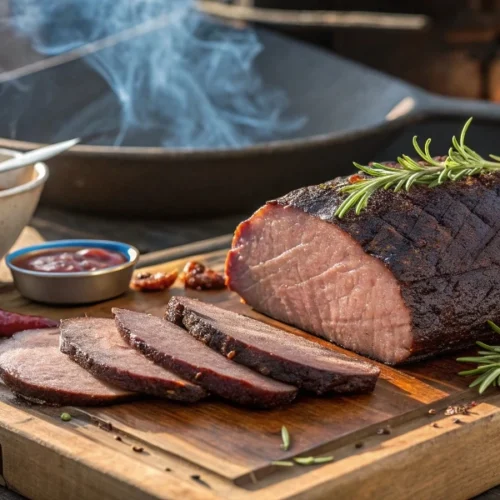
smoker recipe
Learn how to create the perfect smoker recipe with this detailed guide. From choosing the right wood chips to the best meats for smoking, we cover everything you need to know for mouthwatering BBQ results. Whether you're a beginner or a seasoned pro, you'll find all the tips and techniques for achieving smoky, tender, and flavorful dishes. Fire up your smoker and elevate your grilling game with this easy-to-follow recipe.
Ingredients
- Ingredients:
- 2 to 3 pounds of Pork Ribs or any meat of choice, like brisket, chicken, or pulled pork
- 1/4 cup brown sugar
- 2 tablespoons paprika
- 1 tablespoon garlic powder
- 1 tablespoon onion powder
- 1 teaspoon chili powder optional for heat
- 1 teaspoon salt
- 1 teaspoon black pepper
- 1 tablespoon mustard for coating the meat before applying the rub
- 1 to 2 cups wood chips or chunks hickory, applewood, or mesquite for flavor
- BBQ sauce optional for serving or glazing during the last stages of smoking
- Alternatives:
- Use cherry wood or oak chips for a different flavor profile.
- Substitute honey or soy sauce in your marinade for a sweet-savory option.
Notes
Step-by-Step Instructions for Smoking Meat
Step 1: Prep the Meat
- Dry the Meat: Start by patting your meat dry with paper towels to remove any excess moisture. This step is crucial for the rub to stick properly.
- Coat the Meat with Mustard: Rub a thin layer of mustard all over the meat. This acts as a binder for the dry rub and helps form a nice crust.
- Apply the Rub: Generously coat the meat with your prepared dry rub, ensuring it is evenly covered on all sides. Let the meat sit at room temperature for about 30 minutes to absorb the flavors before smoking.
Step 2: Prepare the Smoker
- Preheat the Smoker: Start your smoker and bring it to a steady temperature of 225°F (107°C). If you're using a charcoal smoker, arrange the coals on one side to create indirect heat. For electric or gas smokers, follow the manufacturer's instructions to reach the desired temperature.
- Add Wood Chips: Place your wood chips or chunks into the smoker box or directly on the coals (if using a charcoal smoker). You can use hickory, applewood, or mesquite, depending on your flavor preference. Soak the chips in water for about 30 minutes if they are dry to ensure they produce smoke rather than just burning up.
Step 3: Place the Meat in the Smoker
- Arrange the Meat: Once the smoker is preheated, place your meat on the smoker grate, ensuring it’s not directly over the heat source to ensure slow cooking. If you're smoking ribs or other cuts, make sure there’s enough space around them for the smoke to circulate evenly.
- Close the Lid: Close the smoker lid to retain heat and smoke. Try to avoid opening the lid frequently, as this can cause temperature fluctuations and slow down the cooking process.
Step 4: Maintain a Steady Temperature
- Monitor the Temperature: Keep the smoker temperature around 225°F (107°C) throughout the cooking process. You may need to add more charcoal or adjust the vents to maintain this temperature.
- Check the Meat: Although it's important not to open the smoker too often, you should monitor the internal temperature of the meat using a meat thermometer. The internal temperature for different meats varies:
- Pork Ribs: 190°F (88°C) for tender, fall-off-the-bone results.
- Brisket: 195°F (90°C) for a perfectly tender cut.
- Chicken: 165°F (74°C) to ensure it’s fully cooked.
Step 5: Add More Wood Chips
- Replenish Wood Chips: Every hour or so, add more soaked wood chips to maintain the smoke. You want a steady flow of smoke to infuse the meat with flavor.
Step 6: Check for Tenderness
- Test for Tenderness: For tougher cuts like brisket or pork shoulder, you can check for tenderness by inserting a probe or skewer into the meat. If it slides in with little resistance, it’s done. If not, continue smoking and checking every 30 minutes.
Step 7: Glaze the Meat (Optional)
- If you like your meat with a glaze or additional sauce, brush on your BBQ sauce during the last 30 minutes of smoking. This will help the sauce set and caramelize without burning.
Step 8: Rest the Meat
- Remove and Rest: Once your meat has reached the desired internal temperature and is tender, remove it from the smoker. Let it rest for 10-15 minutes. This resting period allows the juices to redistribute and ensures a moist, flavorful result.
Step 9: Slice and Serve
- Slice the Meat: Depending on the type of meat, slice it against the grain (for brisket) or shred it (for pulled pork) for the best texture.
- Serve: Plate your smoked meat and garnish with fresh herbs for a touch of color. Serve it with your favorite BBQ sides like coleslaw, baked beans, or cornbread.